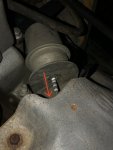- 568
- 1,376
- 93
- Location
- AL
I have a stock 6.5L TD in my recently acquired M1151A1. I haven't driven it very much because I am still waiting on the SF97. The times that I have driven it, I have noticed very little turbo whine until reaching higher rpm levels. I was therefore, wanting to confirm that my turbo was operating properly by marking my waste gate rod so that I could more easily see it's movement while reving the engine. I increased rpm's to approximately 2200 before seeing any appreciable movement and even that was slight. Are there any parameters at which the waste gate should begin to open and/or be fully opened?



